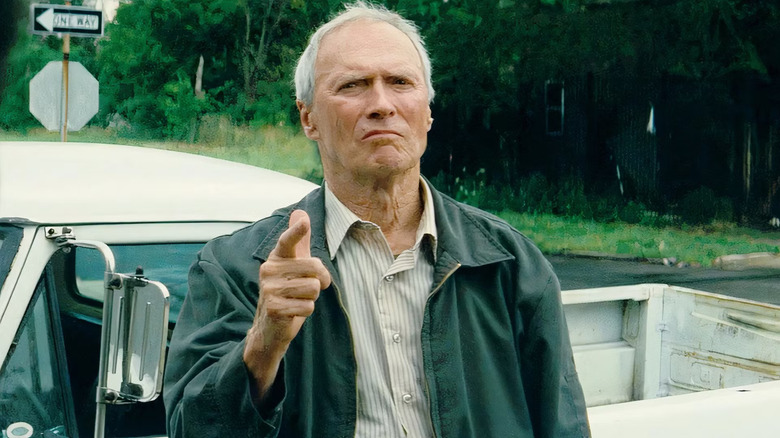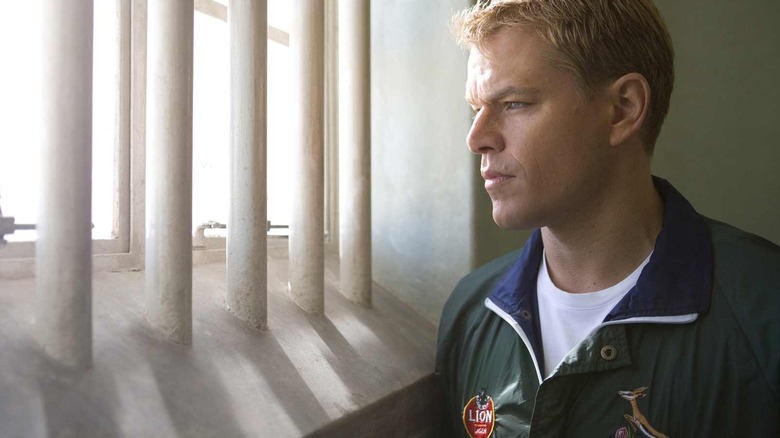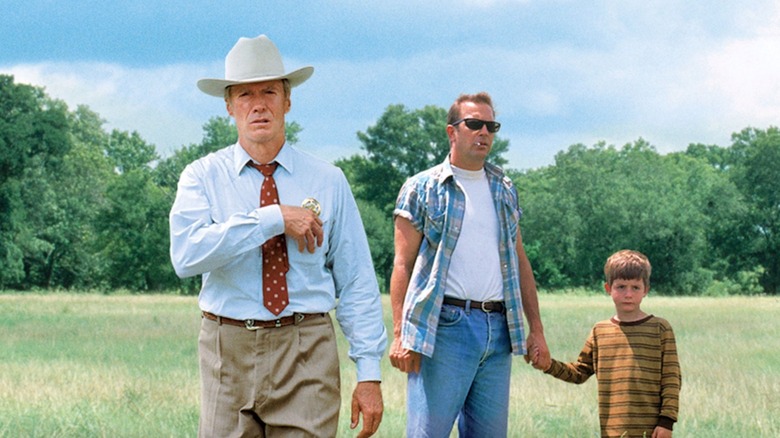A Yellowstone Star Is The Only Actor Who Ever Dared To Clash With Clint Eastwood
Clint Eastwood is a man of few words — at least, he tries to be. This is what makes his appearance on the sadly erstwhile television series "Inside the Actors Studio," hosted by the late, great James Lipton, such riveting television. On a talk show where Lipton encouraged interviewees to be open and loquacious, Eastwood often resisted the host's attempts to find parallels between his private and professional life. It's an incredibly good-natured conversation, but Eastwood lets Lipton know when he's ready to move on, or skip altogether, a subject he rather not discuss. (When asked if he was a "solitary child," the star laughs and fires back, "Is this a psychiatric course?")
Moving on has been a central theme in Eastwood life. When he was a young man, his father told him, "You either progress or decay," a philosophy the star has long observed as an actor and a director. Eastwood has never had much truck for artistic indulgence. Having honed his craft as a performer over eight seasons of the television Western "Rawhide" on CBS (which ran from 1959 to 1965), Eastwood grew accustomed to knocking out one episode per week. There was only so much time to fiddle with the script, which gave the actors little space to modulate their portrayal. Once you've been on a show for more than a season, everyone on set expects you to know your character so well that the performance is essentially second nature.
When Eastwood began directing films in 1971 with the masterful suspense flick "Play Misty for Me," he held himself and his actors to the same standard of preparation. Provided you haven't been miscast, if you know your lines and hit your marks, Eastwood believes one take is all you should need. And then, yes, it's time to move on.
This is the way it has always been with Eastwood, and he doesn't make exceptions — even if you happen to be the biggest star in Hollywood at the moment.
You have to beg him for a second take
Actors who've worked with Eastwood in the past suggest that his preference for one take (even shooting the rehearsal) is really about making sure the day's work can get done in a timely fashion. This is in part because Eastwood — a big family man who likes to shoot films close to home due to the fact that he can't logistically uproot, according to his longtime cinematographer Jack N. Green, the 60 or 70 relatives in his orbit for several months — wants his cast and crew to put in a regular eight hour day (as opposed to the brutally long hours often experienced on a film set). This way, everyone gets to go home, have dinner with their loved ones, and get a decent night's sleep.
In a 2012 Esquire profile of Eastwood, Matt Damon, who starred in the filmmaker's "Invictus" and "Hereafter," "You have to beg him for a second take. I did once, and he said, 'Why, so you can waste everybody's time?'" Jeff Daniels, who co-starred in Eastwood's "Blood Work," said, "You get one take, and you move on. You're just like, 'Really?' And he goes, 'Oh, we're good.' And by the time you ran that little two-line exchange, the camera's already being moved and lights are being taken down. Lunch is being served."
In a 2003 interview with DGA Quarterly (that is currently offline), Eastwood pushed back against this perception of his directorial technique. As he told the magazine:
"Everybody keeps saying, 'Well, he only does one take'. Even if that were true, I don't like the reputation. I don't think anybody likes that efficiency label. What I like is to be efficient with the storytelling. To me, it's whatever it takes to do the job. I'm not out to save a buck. We've budgeted a film, and it will live within the budget, that's for sure."
That said, I'm not sure storytelling efficiency was foremost on his mind when he clashed with Kevin Costner on the set of "A Perfect World."
Clint Eastwood shot a scene with Kevin Costner's extra on A Perfect World
"A Perfect World" was Eastwood's 1993 follow-up to "Unforgiven," for which he'd won the Academy Awards for Best Picture and Best Director. The film was already a big deal before Eastwood cast Kevin Costner (who won Best Picture and Best Director for 1990's "Dances with Wolves") to star as a murderer who escapes from prison and kidnaps a young boy. Though this character is a truly dangerous killer, he gradually forms a bond with the child, which requires something of an emotional high-wire act from Costner.
Eastwood initially didn't want to direct "A Perfect World," but Costner, who was keen on sharing the screen with the Hollywood legend, convinced him to take it on. Evidently, Costner hadn't done his homework prior to the shoot because he soon found Eastwood's trademark "move along" ethos anathema to his way of working.
This all came to a head when Costner left a ready-to-roll Eastwood waiting because he needed more time to prepare. Eastwood didn't ask twice. The director turned to a crew member and said, "Find his extra, and put a shirt on him."
The scene only required Costner to walk through a field out of focus, so Eastwood could easily (and, as ever, quickly) get what he needed without his star. It was at this point that Costner walked out of his trailer, and told Eastwood he was ready to shoot. "Never mind," Eastwood told him. "We're moving on." When a stunned Costner asked if he'd just shot a scene with his extra, Eastwood replied, "I get paid to burn film."
The fast-moving Eastwood and perfectionist Costner proved to be a poor fit on set, but they made an absolutely wonderful film together. It is highly unlikely that they'll ever work together again, but, if they did, maybe an older and wiser Costner would be more receptive to Eastwood's approach — especially since he's spent loads of his own money on his still-unfinished Western "Horizon: An American Saga." If nothing else, moving on gets the job done.


